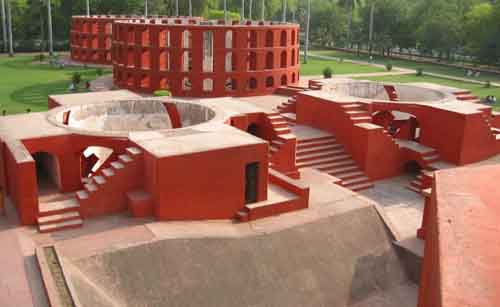Jantar Mantar, Delhi
From Wikipedia, the free encyclopedia
The Jantar Mantar is located in the modern city of New Delhi. It consists of 13 architectural astronomy instruments. The site is one of five built by Maharaja Jai Singh II of Jaipur, from 1724 onwards, as he was given by Mughal emperorMuhammad Shah the task of revising the calendar and astronomical tables. There is a plaque fixed on one of the structures in the Jantar Mantar observatory in New Delhi that was placed there in 1910 mistakenly dating the construction of the complex to the year 1710. Later research, though, suggests 1724 as the actual year of construction.
The primary purpose of the observatory was to compile astronomical tables, and to predict the times and movements of the sun, moon and planets. Some of these purposes nowadays would be classified as astronomy.
Completed in 1724, the Delhi Jantar Mantar had decayed considerably by 1867. Much like the Great Sphinx of Egypt, however, it was not too late to return the calculating instruments of Delhi’s Jantar Mantar to their former glory.
Contents
[hide]Purpose of Individual Structures[edit]
There are distinct instruments within the observatory of Jantar Mantar in New Delhi: the Samrat Yantra, the Ram Yantra, the Jayaprakash, and the Mishra yantras.
- Samrat Yantra: The Samrat Yantra, or Supreme Instrument, is a giant triangle that is basically an equal hour sundial. It is 70 feet high, 114 feet long at the base, and 10 feet thick. It has a 128-foot-long (39 m) hypotenuse that is parallel to the Earth's axis and points toward the North Pole. On either side of the triangle is a quadrant with graduations indicating hours, minutes, and seconds. At the time of the Samrat Yantra's construction, sundials already existed, but the Samrat Yantra turned the basic sundial into a precision tool for measuring declination and other related coordinates of various heavenly bodies.
- Jayaprakash Yantra: The Jayaprakash consists of hollowed out hemispheres with markings on their concave surfaces. Crosswires were stretched between points on their rim. From inside the Ram, an observer could align the position of a star with various markings or a window's edge.
- Misra Yantra:
The Misra Yantra was designed as a tool to determine the shortest and longest days of the year. It could also be used to indicate the exact moment of noon in various cities and locations regardless of their distance from Delhi – quite remarkable! The Mishra yantras were able to indicate when it was noon in various cities all over the world and was the only structure in the observatory not invented by Jai Singh II.
Other observatories[edit]
In all, between 1727 and 1734, Jai Singh II, built five similar observatories, Jantar Mantars, in west central India, all known by the same name, thus includes ones at Jaipur -Jantar Mantar (Jaipur), Ujjain, Mathura and Varanasi. Today the observatory is mainly a tourist attraction, and is significant in the history of astronomy.




1 comment:
Corbett tour travels is one of the best place to visit where you can explore wildlife in Corbett National Park.
Post a Comment